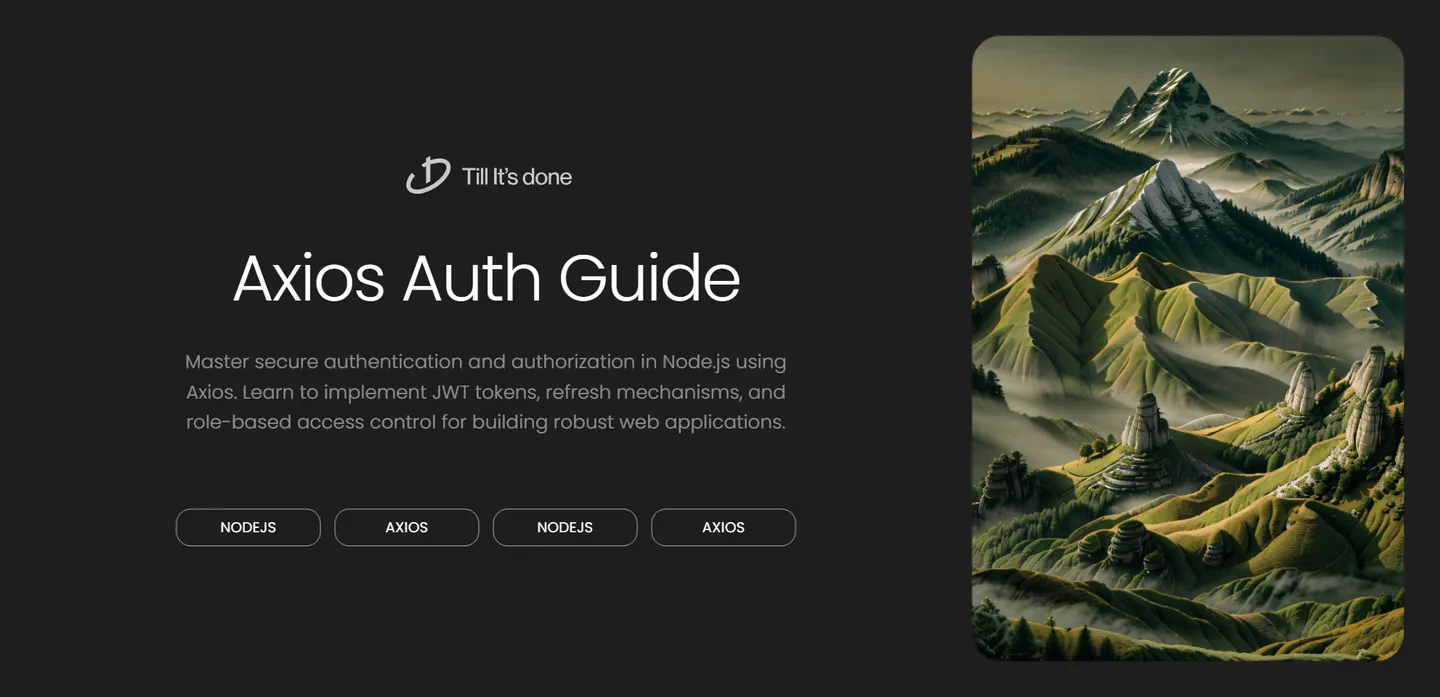- Services
- Case Studies
- Technologies
- NextJs development
- Flutter development
- NodeJs development
- ReactJs development
- About
- Contact
- Tools
- Blogs
- FAQ
Authentication & Authorization with Axios in Node.js
Learn to implement JWT tokens, refresh mechanisms, and role-based access control for building robust web applications.


In today’s interconnected world, securing our web applications has become more crucial than ever. As developers, we need to ensure our Node.js applications handle authentication and authorization properly. Let’s dive into how we can achieve this using Axios, a popular HTTP client library.
Understanding the Basics
Before we jump into the implementation, let’s clarify the difference between authentication and authorization. Authentication verifies who you are, while authorization determines what you can do. Think of it as entering a building - authentication is showing your ID at the entrance, while authorization is having the right keycard to access specific floors.
Setting Up Axios Interceptors
Interceptors are one of Axios’s most powerful features for handling authentication. They act like middleware, allowing you to modify requests before they’re sent and responses before they’re handled.
const axios = require('axios');
// Create an axios instanceconst api = axios.create({ baseURL: 'https://api.example.com'});
// Request interceptorapi.interceptors.request.use( config => { const token = localStorage.getItem('token'); if (token) { config.headers.Authorization = `Bearer ${token}`; } return config; }, error => { return Promise.reject(error); });
Handling JWT Authentication
JSON Web Tokens (JWT) have become the standard for modern web authentication. Here’s how to implement JWT authentication with Axios:
async function login(username, password) { try { const response = await axios.post('/auth/login', { username, password });
const { token } = response.data; localStorage.setItem('token', token);
return token; } catch (error) { console.error('Login failed:', error); throw error; }}Implementing Refresh Tokens
To enhance security while maintaining a smooth user experience, we can implement refresh token logic:
api.interceptors.response.use( response => response, async error => { const originalRequest = error.config;
if (error.response.status === 401 && !originalRequest._retry) { originalRequest._retry = true;
const refreshToken = localStorage.getItem('refreshToken'); const newToken = await refreshAccessToken(refreshToken);
axios.defaults.headers.common['Authorization'] = `Bearer ${newToken}`; return api(originalRequest); }
return Promise.reject(error); });
Role-Based Authorization
Implementing role-based access control (RBAC) adds another layer of security:
function checkPermission(requiredRole) { return async (req, res, next) => { const token = req.headers.authorization?.split(' ')[1]; if (!token) { return res.status(401).json({ message: 'No token provided' }); }
try { const decoded = jwt.verify(token, process.env.JWT_SECRET); if (!decoded.roles.includes(requiredRole)) { return res.status(403).json({ message: 'Insufficient permissions' }); } next(); } catch (error) { return res.status(401).json({ message: 'Invalid token' }); } };}Best Practices and Security Considerations
- Always use HTTPS in production
- Implement token expiration
- Sanitize user inputs
- Use environment variables for sensitive data
- Implement rate limiting
- Keep your dependencies updated
Remember, security is not a one-time implementation but an ongoing process. Regular security audits and staying updated with the latest security practices are crucial for maintaining a robust authentication system.

 สร้างเว็บไซต์ 1 เว็บ ต้องใช้งบเท่าไหร่? เจาะลึกทุกองค์ประกอบ website development cost อยากสร้างเว็บไซต์แต่ไม่มั่นใจในเรื่องของงบประมาณ อ่านสรุปเจาะลึกตั้งแต่ดีไซน์, ฟังก์ชัน และการดูแล พร้อมตัวอย่างงบจริงจาก Till it’s done ที่แผนชัด งบไม่บานปลายแน่นอน
สร้างเว็บไซต์ 1 เว็บ ต้องใช้งบเท่าไหร่? เจาะลึกทุกองค์ประกอบ website development cost อยากสร้างเว็บไซต์แต่ไม่มั่นใจในเรื่องของงบประมาณ อ่านสรุปเจาะลึกตั้งแต่ดีไซน์, ฟังก์ชัน และการดูแล พร้อมตัวอย่างงบจริงจาก Till it’s done ที่แผนชัด งบไม่บานปลายแน่นอน  Next.js สอน 14 ขั้นตอนเบื้องต้น: สร้างโปรเจกต์แรกใน 30 นาที เริ่มต้นกับ Next.js ใน 14 ขั้นตอนเพียงแค่ 30 นาที พร้อม SSR/SSG และ API Routes ด้วยตัวอย่างโค้ดง่าย ๆ อ่านต่อเพื่อสร้างโปรเจ็กต์แรกได้ทันทีที่นี่
Next.js สอน 14 ขั้นตอนเบื้องต้น: สร้างโปรเจกต์แรกใน 30 นาที เริ่มต้นกับ Next.js ใน 14 ขั้นตอนเพียงแค่ 30 นาที พร้อม SSR/SSG และ API Routes ด้วยตัวอย่างโค้ดง่าย ๆ อ่านต่อเพื่อสร้างโปรเจ็กต์แรกได้ทันทีที่นี่  วิธีสมัคร Apple Developer Account เพื่อนำแอปขึ้น App Store ทีละขั้นตอน อยากปล่อยแอปบน App Store ระดับโลก มาอ่านคู่มือสมัคร Apple Developer Account พร้อมเคล็ดลับ TestFlight และวิธีอัปโหลดที่ง่ายในบทความเดียวนี้ได้เลย
วิธีสมัคร Apple Developer Account เพื่อนำแอปขึ้น App Store ทีละขั้นตอน อยากปล่อยแอปบน App Store ระดับโลก มาอ่านคู่มือสมัคร Apple Developer Account พร้อมเคล็ดลับ TestFlight และวิธีอัปโหลดที่ง่ายในบทความเดียวนี้ได้เลย  TypeScript Interface คืออะไร? อธิบายพร้อมวิธีใช้และข้อแตกต่างจาก Type เรียนรู้วิธีใช้ TypeScript Interface เพื่อสร้างโครงสร้างข้อมูลที่ปลอดภัยและเข้าใจง่าย พร้อมเปรียบเทียบข้อดีข้อแตกต่างกับ Type ที่คุณต้องรู้ ถูกรวมเอาไว้ในบทความนี้แล้ว
TypeScript Interface คืออะไร? อธิบายพร้อมวิธีใช้และข้อแตกต่างจาก Type เรียนรู้วิธีใช้ TypeScript Interface เพื่อสร้างโครงสร้างข้อมูลที่ปลอดภัยและเข้าใจง่าย พร้อมเปรียบเทียบข้อดีข้อแตกต่างกับ Type ที่คุณต้องรู้ ถูกรวมเอาไว้ในบทความนี้แล้ว  Material-UI (MUI) คืออะไร อยากสร้าง UI สวยงามและเป็นมืออาชีพในเวลาอันรวดเร็วใช่ไหม มาทำความรู้จักกับ Material-UI (MUI) ที่ช่วยให้คุณพัฒนาแอปพลิเคชันบน React ได้ง่ายและดูดีในทุกอุปกรณ์
Material-UI (MUI) คืออะไร อยากสร้าง UI สวยงามและเป็นมืออาชีพในเวลาอันรวดเร็วใช่ไหม มาทำความรู้จักกับ Material-UI (MUI) ที่ช่วยให้คุณพัฒนาแอปพลิเคชันบน React ได้ง่ายและดูดีในทุกอุปกรณ์  เปรียบเทียบ 3 วิธีติดตั้ง install node js บน Ubuntu: NVM vs NodeSource vs Official Repo แบบไหนดีที่สุด? เรียนรู้วิธีติดตั้ง Node.js บน Ubuntu ด้วย NVM, NodeSource หรือ Official Repo เลือกวิธีที่เหมาะกับความต้องการของคุณ พร้อมเปรียบเทียบ เพื่อการพัฒนาที่มีประสิทธิภาพ!
เปรียบเทียบ 3 วิธีติดตั้ง install node js บน Ubuntu: NVM vs NodeSource vs Official Repo แบบไหนดีที่สุด? เรียนรู้วิธีติดตั้ง Node.js บน Ubuntu ด้วย NVM, NodeSource หรือ Official Repo เลือกวิธีที่เหมาะกับความต้องการของคุณ พร้อมเปรียบเทียบ เพื่อการพัฒนาที่มีประสิทธิภาพ! Talk with CEO
We'll be right here with you every step of the way.
We'll be here, prepared to commence this promising collaboration.
Whether you're curious about features, warranties, or shopping policies, we provide comprehensive answers to assist you.


